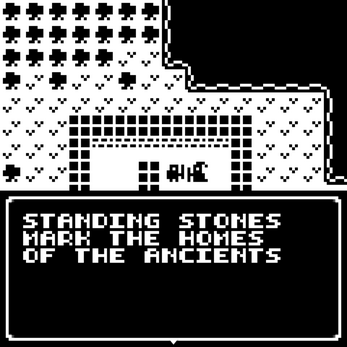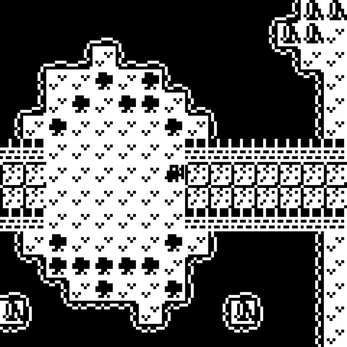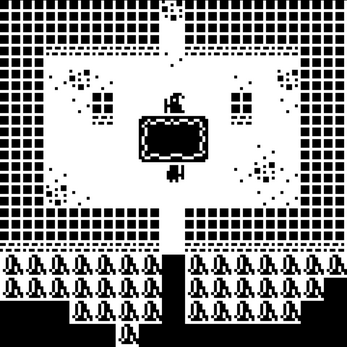The Valley
The Valley is a minimalist pastoral 2D JRPG.
Warning: this game does not have an explicit ending or any way of tracking your completion percent; you should play it until you do not feel like playing it anymore and then quit.
This is my first attempt at making an RPG where the focus is primarily on exploring a space. I intend to make more than one of these but I don't have a good name for this project yet.
---
To keep the focus on exploration I did away with many typical JRPG mechanics, such as combat, inventory management, or goals. In order to help me focus on creating the space, rather than on creating a particular bush or wall segment, I limited myself to using a restricted 1-bit tileset. The game does not offer an explicit narrative or ending. The game also doesn't have music, but who says videogames need music anyway?
Here's a little retrospective on how I came up with these constraints and how they played out:
1. No extraneous tiles/sprites
A JRPG does not need to do anything that Dragon Quest 1 (DQ1) did not do. While replaying DQ1 for research, I noticed that the game uses an extremely minimal vocabulary of tiles, far fewer tiles than are possible on the NES hardware, and far fewer than later games in the series made for the same hardware. The tiles are re-used to represent different objects in the game so that, for example, the tree tile is used to represent a single tree in a castle courtyard, a stand of trees in a town square, or a forest on the overworld map. The same “stone” tile is used for walls of dungeons, houses, castles, etc…
When making The Valley I decided to adopt this constraint, and you will see that I have re-used each tile in the small tileset for making all kinds of different environments: agriculture, ruins, bridges (I love bridges), towns, etc… and the overworld map uses the same tileset as all interior spaces. This was to let me focus on building the space, rather than building the tileset.
Each tile was added to the tileset to express a specific concept, only when no other tile already in the tileset could express it.
2. No Combat / Ludic Trinkets
The Valley is like a walking sim JRPG. However, upon reflection I have realized that doing away with combat/equipment/leveling/party members has left my JRPG without enough “ludic trinkets”.
I use the term “ludic trinket” as a catch all for the “little nothings” in a game that are nice to have. I began this project with the hypothesis that “walking sims don’t have these, so I don’t need them.” On further reflection I have come to believe that, in fact, walking sim do have ludic trinkets, and that The Valley would have benefited from something on top of walking/doors/NPCs. For example: an ancient cypher that the player can learn to read a-la Fez; items that the player can find, which have “lore”; even just “more monuments” could have been enough.
In future projects I will use more ludic trinkets, for example as a way to emphasize the one part of the space is more significant than another, or to add the kind of texture that helps a person explore a space.
3. No extraneous NPCs (NPCs are signposts)
The idea for this project came to me while playing Dragon Quest 11. In DQ11 I made a point of never fighting random encounters in the field (they can be avoided) and never speaking to NPCs unless directed to by the plot. I think I cleared the game ~40 hours, having fought maybe 1 combat every 20 minutes or so.
I got to thinking about why there are NPCs in JRPGs. My feeling was cities or towns have NPCs because they would feel empty/dead otherwise. But this begs the question: why do JRPGs have cities or towns? If you removed the cities and towns, you wouldn’t need the NPCs.
The Valley does not really succeed in this regard: there are towns and villages because I couldn’t feel comfortable without them. NPCs only ever tell you “this or that thing is in this direction” but those NPCs needed an internal logic, and that internal logic ended up defaulting into the logic of towns, and even ultimately agriculture. In future projects I will continue to refine the place of NPCs.
4. No explicit narrative, only setting
As much as possible, I have not included a plot or quests or lore. I have failed at this to some extent, it turns out to be harder than I thought at first. At one point I almost lapsed into a mostly linear narrative. My goal was to attempt to design a 2D JRPG to really emphasize exploration, and I felt that explicit narratives, goals, etc… would only get in the way. If they player chooses to speak to an NPC they will learn of the location of another location, and if it interests them they can try to go there.
I've been playing Nymph's Tower recently and it reminded me of how much of a living narrative you can still achieve by just giving the player a space to explore.
---
Please enjoy playing The Valley.
| Status | Released |
| Platforms | HTML5 |
| Rating | Rated 4.8 out of 5 stars (4 total ratings) |
| Author | arrogant.gamer |
| Genre | Role Playing |
| Made with | RPG Maker |
| Tags | JRPG, RPG Maker, Walking simulator |
Development log
- I made a JRPG walking sim!Feb 27, 2022


